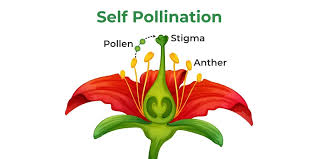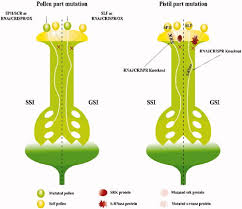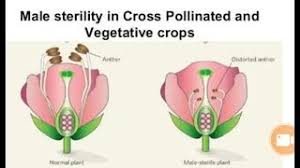This article introduces factors that encourage self and cross-pollination in crop plants, which may be due to flower structure, gametophytic, sporophytic incompatibility, or sterility systems.
Read Also: How to Grow, Use and Care for Whitetinge Sedge Grass (Carex albicans)
Self Pollination Process in Crops

Self-pollination is the process of transferring pollen grains from the anther of a flower to the stigma of the same flower.
Factors That Encourage Self Pollination:
1. Cleistogamy: Flowers do not open at all (e.g., wheat).
2. Chasmogamy: Flowers open but pollinate after opening (e.g., rice).
3. Homogamy: The stamens and carpels of a flower mature simultaneously, increasing the chance for self-pollination.
4. Anther and Stigma Positioning: Close positioning of anthers and stigma promotes self-pollination in crops like tomato.
Cross Pollination in Crops
Transfer of pollen grains from one flower to the stigma of another flower borne on different plants is called cross-pollination. This process requires external agents such as wind, water, or animals like insects, birds, and snails.
Factors That Encourage Cross Pollination:
1. Dichogamy: The phenomenon where male and female sex organs mature at different times:
i. Protandry: Anthers mature before stigma.
ii. Protogyny: Stigma matures before anther.
These traits are common in monoecious plants, which have both male and female parts on the same plant (e.g., maize).
Read Also: How to Grow, Use and Care for Whitegrass (Leersia virginica)
Incompatibility Systems in Plants

Self-incompatibility occurs when fertile pollen and ovules are produced in a bisexual flower, but the pollen cannot fertilize the ovule due to physiological hindrances. This prevents fertilization and seed formation. Self-incompatibility is genetically controlled and enforces cross-pollination.
1. Homomorphic Incompatibility: There are no morphological differences in the flower, and it is of two types:
2. Gametophytic Incompatibility: The incompatibility is determined by the genotype of the gametophyte and governed by multiple alleles of the “S” gene in pollen.
In gametophytic incompatibility, the pollen tube does not grow down the style, preventing fertilization. In compatible matings, the pollen tube grows normally, and fertilization occurs after the pollen tube enters the ovule.
3. Pollen Stigma Interaction:
The growth rate of the pollen tube is controlled by a series of alleles (S1, S2, S3, etc.). Pollen tube growth slows when the pollen allele matches the allele in the style. However, if the alleles differ, the pollen tube grows normally, and fertilization occurs.
Example: If a plant with the genotype S1, S2 is pollinated with pollen from a plant with the same genotype, the pollen tube will not penetrate the style, and fertilization will not occur.
Crosses for Gametophytic Incompatibility:
1. S1S2 x S1S2 – Incompatible.
2. S1S2 x S3S4 – Compatible.
3. S1S2 x S2S3 – Partially compatible.
4. Sporophytic Incompatibility: Here, incompatibility is controlled by multiple alleles with dominant-recessive reactions. The genotype of the pollen-producing plant, rather than the genotype of the female plant, determines the pollen tube growth.
In this system, dominance affects the pollen only, not the female (stylar tissue).
Example:
i. Both plants with the same genotype (S1S2 x S1S2) Incompatible, no functional gametes.
ii. Differing alleles (S1S2 x S3S4): Functional pollen (S1S3, S2S3).
3. Sterility Mechanisms in Plants
Male sterility refers to the inability of a plant to produce or release functional pollen, enforcing cross-pollination. It is extensively used in hybrid seed production and occurs under various conditions:
i. No pollen production or extremely scarce pollen.
ii. Malformation or absence of stamens or male flowers (stiminal sterility).
ii. Normal pollen but inability to open.
Male sterility can arise from:
- Genetic factors inherited through a recessive gene.
- Cytoplasmic factors related to the cytoplasm, not genetic.
- Gene-cytoplasm interactions a combination of genetic and cytoplasmic factors.
4. Genetic Male Sterility This arises from a recessive gene pair, often termed msms.
- MsMs – Fertile.
- Msms – Fertile.
- msms – Sterile.
Maintenance of Male Sterility:
Male sterility is typically maintained in a heterozygous state. In a cross between a male sterile plant and a fertile one, half the progeny will be male sterile (msms) and half male fertile (Msms).
Example: A cross between
Msms and a female sterile line will produce 1/2 male fertile and 1/2 male sterile plants, with the male sterile plants discarded.
5. Cytoplasmic Male Sterility: Controlled by cytoplasmic factors, not genetic. Fertility restoration can occur if fertility-restoring genes are present. This is common in vegetative crops such as onions.
i. Sterile cytoplasm (S) results in male-sterile progeny.
ii. Fertile cytoplasm (F) results in male-fertile progeny.
iii. Restorer genes (Rf) can restore fertility by overriding sterile cytoplasm.
6. Cytoplasmic-Genetic Interaction in Male Sterility:This mechanism depends on the interaction between genetic and cytoplasmic factors.
Example:
- A plant with (Srfrf) genotype will be male sterile.
- A plant with (SRfRf) will be male fertile due to fertility-restoring genes.
7. Crosses for Cytoplasmic Male Sterility:
i. Srr (Sterile cytoplasm) x Frr (Fertile cytoplasm) – Male sterile progeny.
ii. Srr x SRr – 50% male fertile, 50% male sterile progeny.
This article serves as a practical demonstration of these principles, helping to understand why self and cross-pollination occur in crop plants and how sterility mechanisms operate.

